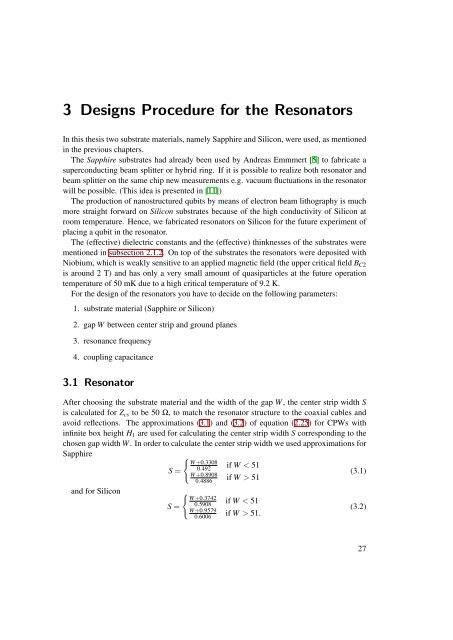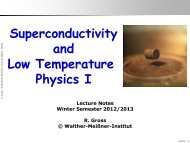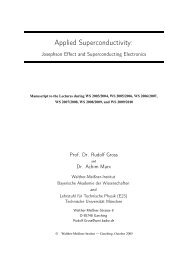Design, Fabrication and Characterization of a Microwave Resonator ...
Design, Fabrication and Characterization of a Microwave Resonator ...
Design, Fabrication and Characterization of a Microwave Resonator ...
Create successful ePaper yourself
Turn your PDF publications into a flip-book with our unique Google optimized e-Paper software.
3 <strong>Design</strong>s Procedure for the <strong>Resonator</strong>sIn this thesis two substrate materials, namely Sapphire <strong>and</strong> Silicon, were used, as mentionedin the previous chapters.The Sapphire substrates had already been used by Andreas Emmmert [5] to fabricate asuperconducting beam splitter or hybrid ring. If it is possible to realize both resonator <strong>and</strong>beam splitter on the same chip new measurements e.g. vacuum fluctuations in the resonatorwill be possible. (This idea is presented in [11])The production <strong>of</strong> nanostructured qubits by means <strong>of</strong> electron beam lithography is muchmore straight forward on Silicon substrates because <strong>of</strong> the high conductivity <strong>of</strong> Silicon atroom temperature. Hence, we fabricated resonators on Silicon for the future experiment <strong>of</strong>placing a qubit in the resonator.The (effective) dielectric constants <strong>and</strong> the (effective) thinknesses <strong>of</strong> the substrates werementioned in subsection 2.1.2. On top <strong>of</strong> the substrates the resonators were deposited withNiobium, which is weakly sensitive to an applied magnetic field (the upper critical field B C2is around 2 T) <strong>and</strong> has only a very small amount <strong>of</strong> quasiparticles at the future operationtemperature <strong>of</strong> 50 mK due to a high critical temperature <strong>of</strong> 9.2 K.For the design <strong>of</strong> the resonators you have to decide on the following parameters:1. substrate material (Sapphire or Silicon)2. gap W between center strip <strong>and</strong> ground planes3. resonance frequency4. coupling capacitance3.1 <strong>Resonator</strong>After choosing the substrate material <strong>and</strong> the width <strong>of</strong> the gap W, the center strip width Sis calculated for Z cs to be 50 Ω, to match the resonator structure to the coaxial cables <strong>and</strong>avoid reflections. The approximations (3.1) <strong>and</strong> (3.2) <strong>of</strong> equation (2.25) for CPWs withinfinite box height H 1 are used for calculating the center strip width S corresponding to thechosen gap width W. In order to calculate the center strip width we used approximations forSapphire{W+0.3308S =0.492if W < 51(3.1)W+0.89080.4886if W > 51<strong>and</strong> for SiliconS ={W+0.37420.5908if W < 51W+0.95790.6006if W > 51.(3.2)27
















